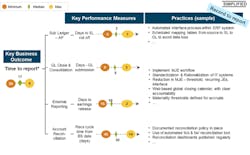Separating Impact from Hype: How CFOs Achieve Technology ROI
Why do so many technology upgrades fall short of their goals? How can the vast capabilities of modern technology tools still fail to meet critical user needs or provide material return on investment—with the goal of cost-to-serve, agility and adaptability, standardization or scalability? Why do so many companies reach the end of a multi-year deployment only to discover they are not materially better off than before, and that the world has moved on to the next big thing?
The answer lies in how they approach IT. Too many companies view technology as the primary factor in greater efficiency. They fail to engage in a deep analysis of the processes IT must support or how people will leverage technology. Many implement a vast array of process and technology improvements rather than surgically target the actual drivers of desired business outcomes. Sometimes there is a disconnect between what the CIO perceives as necessary and what the CFO needs to accomplish. And, too often, a carefully planned deployment meant to address particular problems is implemented so slowly that by the end, business needs have radically changed and the solution is no longer adequate.
ERP is no longer the only answer
A huge, multi-year implementation is no longer the only option available to leverage better technology. In fact, massive implementations can sometimes undermine actual business goals. While there is still room for enterprise resource planning systems, ERP systems seldom address all business needs, and may not promote business goals of simplicity, efficiency and speed of deployment. ERP systems are also prone to expensive customizations, are non-intuitive to business users, and can result in highly fragmented backend IT systems and “data islands” that are costly to man and hard to evolve.
By contrast, consider the example of a global claims management provider that sought to improve its manual and disparate accounts receivable (AR) and collections processes. It chose to deploy a cloud-based, end-to-end software as a service (SaaS) suite of financial and accounting applications in its U.S. operation. A test within a chosen business unit produced improvement so significant that the company moved up the scheduled rollout of the solution to the rest of the U.S. operation by six months. Because the new system easily accesses legacy ERP data but is much more user-friendly, collectors who previously felt as though they were working on separate islands now feel part of one team.
Process is key to better technology ROI
Too many companies fail to closely examine the processes they need to support—specifically the key business outcomes those processes must deliver—before moving ahead with technology upgrades or new deployments. Instead enterprises should harness domain and process expertise for that purpose, well beyond functional process design specifications—in three steps.
First, identify the most important outcomes to be achieved, and then determine what metrics must be measured to drive results. Then, measure the current performance, benchmark it (either internally or externally), and determine the potential gaps. Finally, pinpoint what technology or process interventions are needed to close those gaps (see diagram below). The deliverables of such analyses answer key questions such as: Which parts of the process can be automated? Which might be eliminated? How do the processes impact the effectiveness of various departments or business lines?
Understanding how the end-to-end process links to other parts of the organization lets planners zero in on business practices that will support better enterprise performance, not just sub-process performance. They can then target technologies to help drive better outcomes. For example, in the record to report process, “time to report” is a key business outcome. An effective framework for driving improvement would measure and benchmark the performance of sub-ledger AP metrics such as “days to sub-ledger cutoff,” then develop effective processes that drive movement in those metrics. The underlying technology should support those processes rather than try to force-fit human behavior to accommodate the technology—a common issue in IT-driven projects.
Don’t allow anyone to “boil the ocean”
A process-based approach to technology allows organizations to focus on fewer—but material—parts of the solution. This simplifies organizational alignment as well as technical realization while preserving the business impact. Companies may discover that targeted interventions will solve their problems, at far less cost and with significantly shorter timelines than an enterprise-wide upgrade. Business stakeholders should encourage practical solutions in order to contain the natural tendency of some technology consultants to “do too much” and “cement the solution,” irrespective of the need for simplicity and future agility.
Business stakeholders have a material role to play in the design of technology solutions. They should collaborate thoroughly with IT—and their consultants—to focus efforts and guarantee future flexibility. A robust solution might not last more than a few years because of the likely business changes that will soon intervene. The business case—and related technology choices—must reflect that.
The best technology-based transformation focuses on what matters
Once a more targeted scope has been defined, organizations are better able to leverage advancing technologies: new point solutions, workflows, wrappers and other tools (including those leveraging cloud-based delivery and mobile solutions), instead of defaulting to ERP deployment or optimization. They can use automation to reduce variances and to industrialize processes, but they should bear in mind that automation cannot do everything, and that workflows found within traditional solutions are often too rigid to enable large, distributed groups of people, especially in high-end functions such as FP&A, risk management and controllership.
Tools for collaboration and insight are required in a global economy, and they must be intuitive to be effective. Modern technology users accustomed to mobile apps and easy interfaces expect the same from their business software.
The good news is that today’s technology is much more agile than in the past, able to leapfrog the traditional cycle of upgrades invariably subject to “sunk cost” issues created by older technologies. Cloud-based solutions, mobile extensions and “systems of engagement” can sit on top of traditional “systems of records” (e.g., legacy ERP or data warehouses), increasing efficiency and effectiveness while keeping the effort finite.
The claims management company mentioned above used the new SaaS solution to link its disparate systems and improve AR operations. The new, comprehensive cloud-based solution represented a paradigm shift in their technology deployment while fulfilling their objectives.
The rapid evolution of technology doesn’t mean that enterprises should forego business practices or adopt technology wholesale and in a rush. Instead, thoughtful, process-based design and transformation can harness the newest technology for what matters, thoroughly utilizing process analytics and focusing on how business process (and the related human factor) drives the desired business outcomes, while retaining the flexibility to adapt to future needs.
Sanjay Srivastava is senior vice president, Enterprise Technology Solutions, and Gianni Giacomelli is senior vice president, chief marketing officer and product innovation with Genpact, a consulting firm that specializes in transforming and running business processes and operations, including those that are complex and industry-specific.





